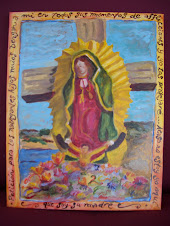I'm launching this blog to support the book I will have written by the time I turn sixty. That is next month, July 21, 2009. It's almost done. I'm calling it Virgin Territory. Let me tell you about it.
In February, 2006, my husband and I sold everything we owned in the States and moved to the Pacific Coast of Mexico just north of Puerto Vallarta. It was a decision made in a burst of either madness or inspiration, a precipitous plunge into retirement -- and renewal. For us, like thousands of other gringos making this move, Mexico represents a new beginning. In that respect, where we now live is definitely "virgin territory."
But Mexico is also the home of Our Lady of Guadalupe, "Goddess of the Americas," an indigenous icon that has been growing in presence and influence both north and south of the border. Her image graces more rearview mirrors, notebook covers and shopping bags than it does church altars. The Virgin of Guadalupe represents a popular religiosity unconfined to any institution, and now, in a time when institutions of many kinds seem rather shakey, she provides a spiritual perspective on what is lasting and important. She is a current symbol of an ancient ethos, a direct encounter with what is colorful and primitive, free-flowing and spontaneous, yet constant and sustaining.
It is my hope that Virgin Territory will speak particularly to women who are ready to move – if not physically, as in Eat, Pray, Love, then mentally – to consider new ways of being present with God, with themselves, and with others. Like Barbara Brown Taylor, they may be Leaving Church. Like Sue Monk Kidd, they're looking hard at religion's traditional authority figures – and often finding them lacking. Like Anne LaMott, they may cast a sardonic eye at social norms and politics, and find refuge in a more primitive Christianity full of grace and humor.
After our move to Mexico, I found myself taking a fresh look at The Virgin of Guadalupe. I'd first had contact with her when I was eight years old and I visited Mexico City with my family. She'd made a lasting – and largely erroneous – impression on me then. Now, over fifty years later, I find she represents far more than I'd ever imagined. To me she is the archetypical feminine spiritual ideal featured in Mary Baker Eddy's major work, Science and Health with Key to the Scriptures, an archetype which I now feel impelled to "unpack" and bring forward to the twenty-first century. The Virgin embodies qualities that humanity needs now, a fresh model of divine expression that goes beyond the confrontational and competitive our-God-is-bigger-than-yours prototype.
What provides the story in Virgin Territory is that the spiritual perspective I've gained from this feminine model has proved practical during our time here. We renovated a house bought on a whim. We had personal health crises and coped with the fraudulent loss of our retirement nest egg. I came to terms with a long-suppressed childhood trauma, discovered talents and artistic inclinations I never dreamed of, and regained a sense of life-purpose and identity beyond a religious denomination, a family name, or a particular nationality. Through it all I became more intimately acquainted with an underlying gentle Mother presence, and began seeing myself as Her reflection. It's made a huge difference in my life, and I think my experience might be helpful to others.
|





No comments:
Post a Comment